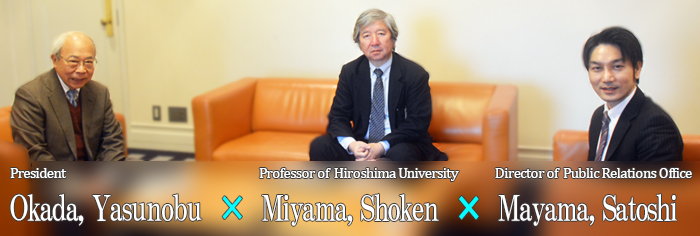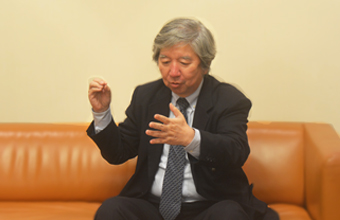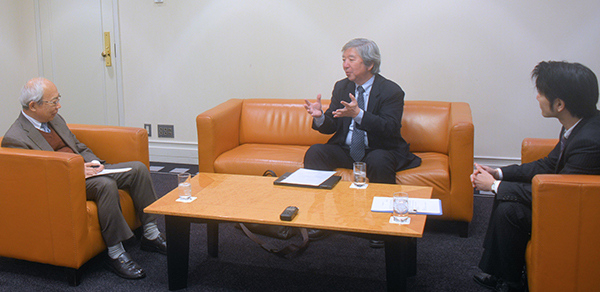[Interview] Professor, Hiroshima University Miyama, Shoken No. 2


Succeeding the human dream of finding life outside of the earth with the establishment of Astrobiology
Mayama Now that we have touched on the topic of living creatures, I would like to ask now about the kind of research the Astrobiology Center was aiming for when you were an executive director at the NINS, and about the future direction of the education system.
Miyama Astrobiology is an extremely new and an interdisciplinary field. The then president Dr. Katsuhiko Sato was also very enthusiastic about advancing this field, and I felt strongly the same way.
Recently, many planetary systems have been discovered besides the solar system, and the number has already reached over 1,000. There seems to be planets where water exists in its liquid form. However, this is only assuming that the planet is at an appropriate distance from the star with the astral body equivalent to our sun.
Dr. Okada, water is extremely important in your field, biological science, too. Astronomers assume that living creatures would come into being easily once you have the necessary environment, such as water, but biologists say that things are not that simple. They tell us that even with the right environment, the intricate and complicated situation of the living beings on the earth only came into being because of the extraordinarily good environment and some coincidences.
We think that if like on earth, we can find ozone in the atmosphere, then there must be plants, and if there is methane, there must be a lot of animals. If there are a lot of living beings breeding on the planet, it will affect the atmosphere, and we are trying to consider the possibility of living beings by looking at such biomarkers.
Okada I see. So you haven't spotted any biomarker at this point.
Miyama No, not yet. If we will find it, it would be the discovery of the century. With the completion of the new telescope, one of the dreams of the human race might come true.
Establishing an interdisciplinary system of research through the field of astronomy
Pursuit for a revolutionary paradigm innovation
Miyama With researchers from fields related to biology and planetary science, we will be able to conduct challenging and interdisciplinary studies on themes such as how can we discover life on planets other than the earth, or how differently life evolves in environments different form that on the earth. I am convinced we would have developments. One of the main motivations for trying to build the huge 30m telescope is to find proof for life outside of our solar system, and I am hoping to involve people from the related fields in this project.
I have been feeling strongly recently that in studies, it is necessary to pursue each genres, but integrating with other genres will enhance the possibility to create new paradigms. Integration of the different fields is something that is also included in the founding principles of SOKENDAI.
Okada Yes, that is what we aim for.
Miyama NINS is a body that integrates the parent institutes of SOKENDAI, and consists of institutions such as the NAOJ, the National Institute for Fusion Science (NIFS), the National Institute for Physiological Sciences (NIPS), the National Institute for Basic Biology (NIBB), and the Institute for Molecular Science (IMS), so I prepared for years to create something where these fields can integrate.
At the beginning, we started with activities such as symposiums open to the public, and forums where researchers could exchange information casually while taking dinner. Then we heard that the Ministry of Education, Culture, Sports, Science and Technology was also moving towards supporting new fields of science and seeing this as a chance, we were able to found the Astrobiology Center.
Our present goal is to have participants from biology related fields. There are many scholars that I associate with, but we have not done anything beyond that at this point. One of the scholars told me that if there is any material proof that there is life outside of earth, he would be more than willing to do research, but if there isn't, he wouldn't know on what and how to conduct research.
Okada Yes, I think he is right. So we may be able to present some arguments, but whether we can do some concrete work is a different issue.
Even if we cannot find or observe something we may consider a biomarker, if there is high possibility that some proof exists, we may be able to conduct some concrete research. For instance, there are even theories that life on earth came from another planet, so we can analyze whether there are organic substances on meteorites that fly to earth, or on objects that fly out into space and then come back.
I am quite grateful that NINS is creating organizations with people from different fields, and is creating new genres. Here at SOKENDAI too, we have interdisciplinary education programs that were founded with the goals to nurture scholars who work in a similar direction. If you can create an education system for astrobiology too, then I think we would have an environment where the younger generations can become interested and continue research in this field.
Astrobiology Center as the pioneer in interdisciplinary education
Miyama So now, I have a request to the President. SOKENDAI consists of the departments based on the parent institutes, but the Astrobiology Center organized by NINS is governed directly by NINS and being independent from the parent institutes, is not directly related SOKENDAI. So if you could be more flexible about this system, and have positions that belong to more than one organization, then young people who want to learn under such educational programs would benefit from that.
Okada For the present, SOKENDAI departments are based on the constituent parent institutes, but I think educational programs that connect departments would become possible in the initiatives beginning from the next fiscal year. I think with accumulation of practical education by the Astrobiology Center, I think we would surely be able to consider departments that are not based or do not depend on a particular parent institute.
So for now, you could establish an interdisciplinary education program that crosses over departments with authority to give credits to students. At the present stage, we cannot have the department by itself, but students will be able to receive credits while belonging to one of the departments.

Miyama We really appreciate that. As I mentioned previously, with the exception of the Okazaki district in Aichi prefecture, the research centers that constitute the SOKENDAI are geographically sparse. The centers do not exist in a single campus like the normal universities, and access is not so good.
Especially for the younger generation, it is important to pursue a certain discipline in depth, but it is becoming the international trend to create new genres through cooperation with other disciplines. So for examples, maybe something to encourage this movement, such as SOKENDAI funds where different fields can make collaborative suggestions and apply for might improve things too.
p.2/3
Related Content
